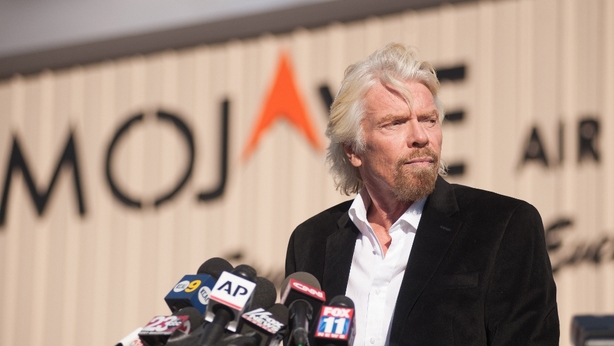The investigation into last week's crash of the Virgin Galactic spaceship has found that the "feathering" function to help it descend into the atmosphere from space was deployed early.
SpaceShipTwo's rotating tail boom, a key safety feature for re-entering the atmosphere, inadvertently rotated early, the US National Transportation Safety Board said.

The agency is leading the investigation into what caused the spacecraft to crash in California's Mojave Desert during a test flight on Friday, killing one pilot and badly injuring the other.
Virgin Galactic is the fledgling space tourism company of billionaire businessman Richard Branson.
NTSB chairman Christopher Hart said investigators had determined the "feathering" system should have been deployed when the vehicle was travelling about 1.4 times the speed of sound.

Instead, the feather began rotating when the vehicle was travelling at Mach 1, he said.
The system, which folds the vehicle in half to create more atmospheric drag, was unlocked early by the co-pilot but a second command to move the feather handle into position was not sent, he said.
Investigators also recovered SpaceShipTwo's propellant tanks and engine intact, indicating there was no explosion.
"The engine burn was normal up until the extension of the feathers," Mr Hart told a news conference.
He emphasised that the NTSB was not saying the early deployment of the ship's feather was the cause of the accident and stressed that the investigation was in its earliest stages.
"We have months and months of investigation," Mr Hart said.
SpaceShipTwo was conducting test flights and was not yet certified for commercial operations when the crash occurred, delaying indefinitely the start of passenger service.
Mr Branson and his son plan to fly on the first commercial flight.

About 800 people already have paid or put down deposits for the journey, which costs $250,000 (€200,000).
The two pilots involved were employees of Scaled Composites, a Northrop Grumman Corp subsidiary that designed and built the six-passenger, two-pilot craft for Virgin Galactic.
Michael Alsbury, 39, has been identified as the co-pilot who died.
Peter Siebold, the 43-year-old pilot riding in the right-hand seat, parachuted to the ground and was recovering at a nearby hospital, Scaled Composites said in a statement.
Mr Branson's company has denied reports it ignored safety warnings ahead of the test flight.
In a statement his company said: "At Virgin Galactic, we are dedicated to opening the space frontier, while keeping safety as our 'North Star'.
"This has guided every decision we have made over the past decade, and any suggestion to the contrary is categorically untrue".
Geoff Daly, an engineer, has filed complaints with several US government agencies over the use of nitrous oxide to power the spaceship's engine.
Friday's crash was the second disaster in less than a week experienced by a private space company.
Last Tuesday, an Antares rocket built and launched by Orbital Sciences Corp exploded after lift off from Wallops Island, Virginia, destroying a cargo ship bound for the International Space Station.

